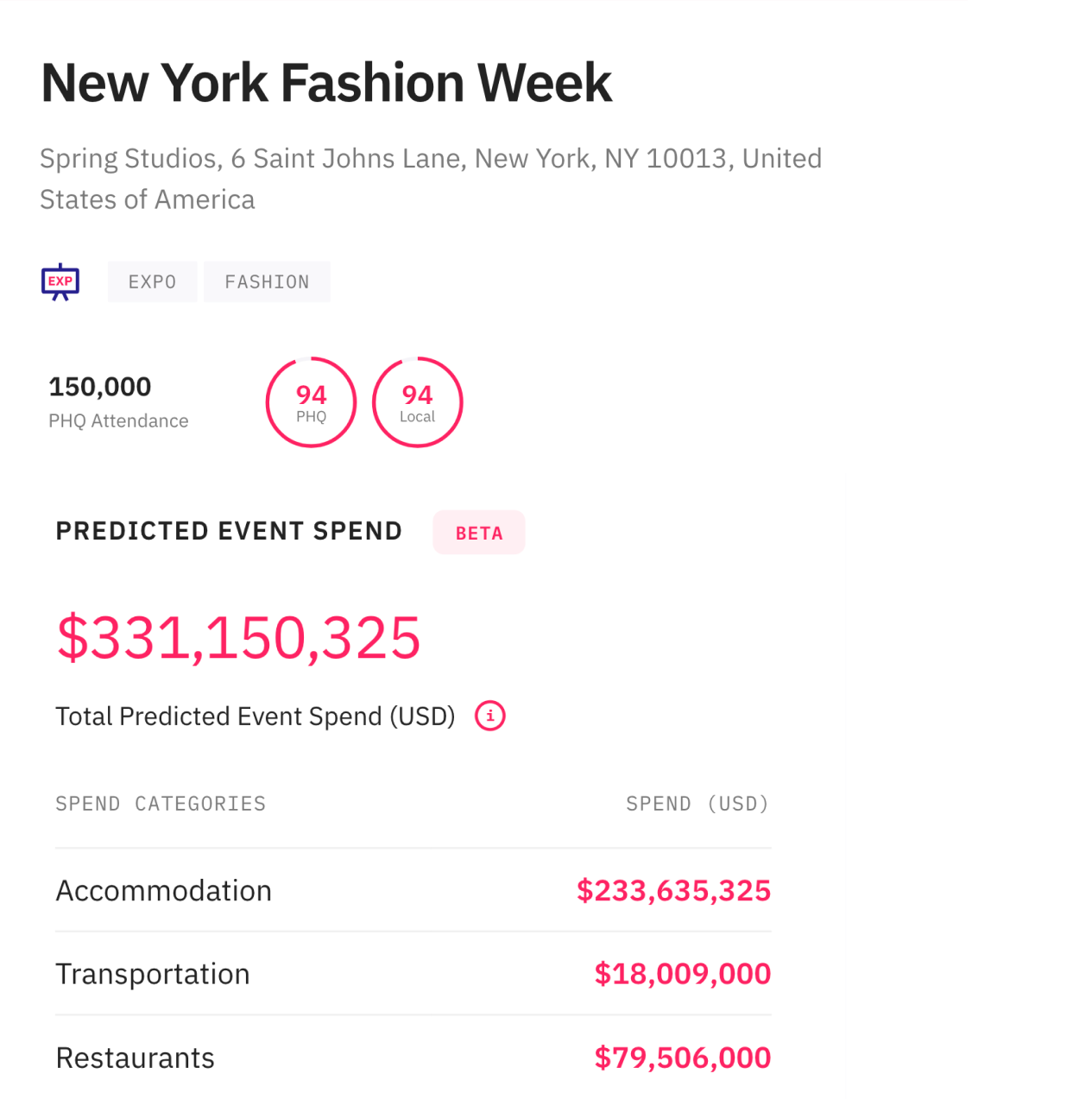Introducing Predicted Event Spend

Instantly find out how an event will impact nearby restaurants, transportation and accommodation businesses
We all know that events impact demand. Whether that is a gathering of thousands of people nearby that will send footfall and demand skyrocketing or an event that takes people away from your business, causing a dip in demand. The more important question for businesses is which events and how much they will impact their specific business. That’s why we built the Predicted Event Spend tool, a predictive analytics solution that answers this question.
The Predicted Event Spend tool is a machine learning model that draws on our verified event data, anonymized customer data, and location data from 7,000 locations to pinpoint the business impact of an event for businesses near an event.
Most economic impact calculators generate figures that are largely unusable for local businesses nearby. This is because they factor in wages, taxes, sponsorships, screening rights and more. While this is important information, it’s not if you’re just trying to work out how many extra staff you need to roster that day to meet the surge in demand, or how to price your rooms or parking spots. But answering those questions is exactly what Predicted Event spend has been built for.
What is Predicted Event Spend?
Predicted Event Spend is a dollar figure estimate for the impact an event will have on local businesses. It includes a figure for accommodation, transportation providers, and restaurants. It draws on:
Our verified and intelligent event data.
Our predicted attendance models which factor in venue, performers, historical attendance, and more to identify an accurate estimate of the event size.
Anonymized customer impact data from our data lake that span across a wide range of businesses
Location specific information such as standard room rates and restaurant prices for around 7,000 locations.
Our event categorization models which identify the category, type and relevant labels to define events.
The machine learning model then generates a predicted event spend. Let’s take a look at SXSW, a major festival in Austin.

At first, more than $89 million can seem like a lot – but having hundreds of thousands of people descend upon a city of fewer than a million people while requiring accommodation, food, and entertainment and transportation for several days adds up quickly.
How the model differentiates between different kinds of events and their impact
Not all events have the same predicted event spend, even if they have the same predicted attendance. For example, New York Fashion Week in February had a predicted attendance of 150,000, as did Super Bowl Weekend (all Super Bowl events on game weekend). But New York Fashion Week was drove $331.1 million in spending, whereas Super Bowl Weekend resulted in $123.7 million in spending for businesses near the event venues.

The main difference here is our model identified that Super Bowl weekend is a sports game and festival, and assumes an average of two people per room to factor in the difference between a family-friendly event, compared to Fashion Week, which is categorized as an expo. For expos and conferences, the model assumes one person per room. The model also factors in significantly raised room pricing for Super Bowl weekend also, given the volume of available accommodation.
The model also carefully considers overlapping events, such as the many events that took place over Super Bowl weekend. Simply summing up every event at a particular time would lead to inaccurate predictions – as the same people will be attending multiple events, rather than a net-new group of people per event.
How to use Predicted Event Spend
PredictHQ created this tool because our customers requested it, but its application will vary significantly based on which industry, and which team, is using it. For example:
QSRs can use it to compare apples to apples i.e. the restaurant spend when it comes to different kinds of events near the same store.
Accommodation businesses can use it to communicate to their hotel managers as to why the pricing recommendations have been increased or decreased, as well as to set appealing minimum stay discounts or similar packaging updates.
Event-based marketing or out-of-home marketing groups can use it to quickly describe the impact of an event for particular segments considering where to place their ads.
Smaller businesses that don’t have the team capacity to use event data extensively in planning can use it as a shorthand for how impactful an event will be, and roster more staff or stock up on inventory accordingly.
Predicted Event Spend is available in our API and in our web application. It is currently in beta. You can find out more about it and how to access it here.






